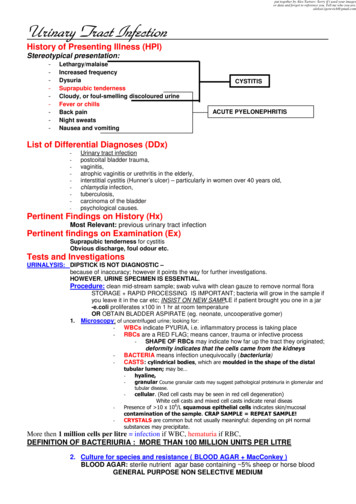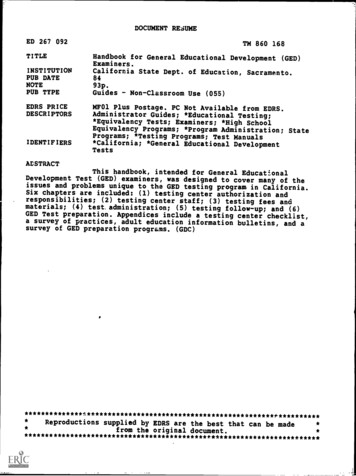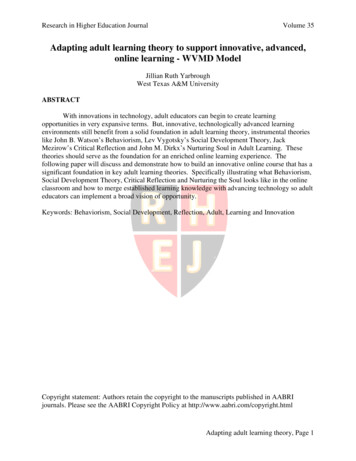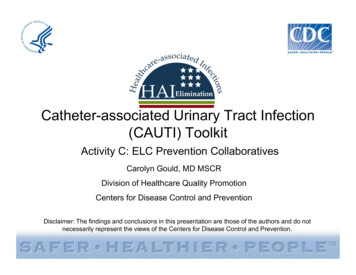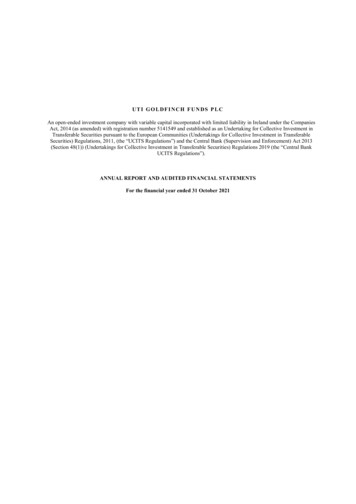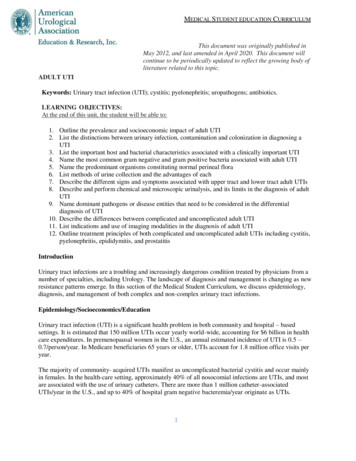
Transcription
MEDICAL STUDENT EDUCATION CURRICULUMThis document was originally published inMay 2012, and last amended in April 2020. This document willcontinue to be periodically updated to reflect the growing body ofliterature related to this topic.ADULT UTIKeywords: Urinary tract infection (UTI); cystitis; pyelonephritis; uropathogens; antibiotics.LEARNING OBJECTIVES:At the end of this unit, the student will be able to:1. Outline the prevalence and socioeconomic impact of adult UTI2. List the distinctions between urinary infection, contamination and colonization in diagnosing aUTI3. List the important host and bacterial characteristics associated with a clinically important UTI4. Name the most common gram negative and gram positive bacteria associated with adult UTI5. Name the predominant organisms constituting normal perineal flora6. List methods of urine collection and the advantages of each7. Describe the different signs and symptoms associated with upper tract and lower tract adult UTIs8. Describe and perform chemical and microscopic urinalysis, and its limits in the diagnosis of adultUTI9. Name dominant pathogens or disease entities that need to be considered in the differentialdiagnosis of UTI10. Describe the differences between complicated and uncomplicated adult UTI11. List indications and use of imaging modalities in the diagnosis of adult UTI12. Outline treatment principles of both complicated and uncomplicated adult UTIs including cystitis,pyelonephritis, epididymitis, and prostatitisIntroductionUrinary tract infections are a troubling and increasingly dangerous condition treated by physicians from anumber of specialties, including Urology. The landscape of diagnosis and management is changing as newresistance patterns emerge. In this section of the Medical Student Curriculum, we discuss epidemiology,diagnosis, and management of both complex and non-complex urinary tract inary tract infection (UTI) is a significant health problem in both community and hospital – basedsettings. It is estimated that 150 million UTIs occur yearly world-wide, accounting for 6 billion in healthcare expenditures. In premenopausal women in the U.S., an annual estimated incidence of UTI is 0.5 –0.7/person/year. In Medicare beneficiaries 65 years or older, UTIs account for 1.8 million office visits peryear.The majority of community- acquired UTIs manifest as uncomplicated bacterial cystitis and occur mainlyin females. In the health-care setting, approximately 40% of all nosocomial infections are UTIs, and mostare associated with the use of urinary catheters. There are more than 1 million catheter-associatedUTIs/year in the U.S., and up to 40% of hospital gram negative bacteremia/year originate as UTIs.1
Urinary infections are treated with antibiotics and removal of predisposing factors when possible,including indwelling catheters. Antibiotic use should be reserved for symptomatic infections and thedecision to proceed with treatment requires thoughtful consideration of collateral impact and antimicrobialresistance patterns.Etiology/PathogenesisDefinitionsUrine is generally considered sterile. The urinary system can be divided into the upper tract, which consistsof the kidneys (renal parenchyma and collecting system) and the ureters, and the lower urinary tract, whichincludes the bladder (responsible for storage and elimination of urine), the urethra (tube through whichurine exits the bladder to the outside world), and prostate in men. In the female, the urethra exits thebladder near the vaginal area, the vagina could contribute to contamination of urine specimens. In themale, the urethra exits the bladder, passes through the prostate, and then through the penile urethra. Theforeskin when present may contribute to infection in select instances. When discussing UTI's it isimportant to distinguish among the following terms: Contamination – organisms are introduced during collection or processing of urine. No health careconcerns.Asymptomatic bacteriuria (Colonization) – organisms are present in the urine but are causing noillness or symptoms. Depending on the circumstances, significance is variable, and the patient oftendoes not require treatment.Infection (UTI) – the combination of a pathogen(s) within the urinary system and symptoms and/orinflammatory response to the pathogen(s) requiring treatment.Uncomplicated UTI – infection in a healthy, non-pregnant, pre-menopausal female patient withanatomically and functionally normal urinary tract.Complicated UTI – infection associated with factors increasing colonization and decreasing efficacyof therapy.Recurrent UTI – occurs after documented infection that had resolved. Defined as 2 or moreinfections in 6 months, or 3 infections in 12 months (JAMA article).Reinfection UTI – a new event with reintroduction of bacteria into urinary tract or by differentbacteria.Persistent UTI – UTI caused by same bacteria from focus of infection.Factors Important for the Genesis of UTIsBacterial entry:Bacteria ascending into the bladder through the urethra is the most common cause of UTIs. There areseveral risk factors that may promote or encourage bacterial ascent.Risk factors for UTIs Reduced Urine Flowo outflow obstruction with incomplete bladder emptying (prostatic hyperplasia, prostaticcarcinoma, urethral stricture, pelvic organ prolapse or foreign body)o neurogenic bladdero inadequate fluid uptakeo voiding dysfunction2
Promote Colonizationo sexual activity – increased inoculationo spermicide – increased bindingo estrogen depletion – increased bindingo antimicrobial agents – decreased indigenous floraFacilitate Ascento catheterization (chronic or intermittent)o urinary incontinenceo fecal incontinenceo residual urine with ischemia of bladder wallHematogenous spread is an uncommon cause of UTIs. The organisms most commonly involved withhematogenous spread are Staphylococcus aureus, Candida species and Mycobacterium tuberculosis.Hematogenous infection develops most often in immunocompromised patients, elderly, or neonates.Relapsing hematogenous infections can be secondary to incompletely treated prostatic or kidneyparenchymal infections (e.g. emphysematous pyelonephritis).Bacterial Uropathogenic Factors:A limited number of E. coli serotypes are responsible for the majority of UTIs. Bacteria that causeinfection have increased adhesion, colonization and tissue invasion properties relative to nonpathogenicbacteria. The mediators of these pathogenic features include pili, cell surface structures responsible foradhesion to host tissues, which promote colonization and increase resistance to bacteriocidal host activity.Specifically, Type 1 pili adhere to mannose receptors on in the urinary epithelial mucopolysaccharidelining as well as polymorphonuclear leukocytes (PMNs); Uropathogenic E. coli with Type I pili are oftenassociated with cystitis (bladder infection). P pili are mannose resistant and adhere to renal glycolipidreceptors. P pili do not bind PMNs and are therefore relatively resistant to phagocytosis and clearing by thehost immune system thus most often associated with kidney infections (pyelonephritis). One characteristicof E. coli that allows it to ascend to the kidney is the phasic variation of Type 1 pili. Intermittent piliexpression decreases opportunity for PMN binding making phagocytosis is less effective. One of thesignificant factors in resistance to bactericidal activity involves the expression of K antigen (capsularpolysaccharide) on bacteria. Another mediator, hemolysin, produced by select bacteria, can augment tissueinvasiveness and predispose to infection.Host Defenses:Several factors relating to host defenses determine susceptibility to UTIs. Mechanical issues such asurethral length (female shorter than male), completeness of bladder emptying (leading to residual urine inthe bladder) and the integrity of the natural uretervesical junction "valve" (leading to vesicoureteral reflux;VUR) are important anatomic issues that predispose to UTIs. Biochemical properties are normallyimportant in making bacterial survival difficult in urine: acid pH, high urea content, and high osmolality.In addition, mucosal mucopolysaccharide within the lining of the urinary tract as well as systemic andlocal antibody production may be protective for UTIs. Finally, there may be a genetic predisposition toUTIs, as certain HLA and Lewis blood group (non-secretor status) factors may put patients at higher riskdue to increased colonization ability or increased adherence by bacteria to the urinary tract epitheliumNatural Defenses of Urinary Tract Periurethral and Urethral Region – Normal flora in these areas contain: lactobacilli,coagulase negative staph, corynebacterium and streptococci that form barriers against3
colonization. Changes in estrogen, low vaginal pH and cervical IgA affect colonization bynormal floraUrine – High osmolality, high urea concentration, low pH, high organic acids are protective.Glucose in urine may facilitate infections. Tamm Horsfall proteins may be protective.Bladder – Epithelium expresses Toll-like receptors (TLRs) that recognize bacteria and initiateimmune/inflammatory response (PMNs, neutrophils, macrophages, eosinophils, NK cells,mast cells and dendritic cells). Adaptive immune response then predominates (T and Blymphocytes). Induced exfoliation of cells also occurs to allow excretion of bacterialcolonization.Kidney – Local immunoglobulin/ antibody synthesis in the kidney occurs in response toinfections (IgG, IgA).Alterations in Host Defense Mechanisms Obstruction – Key factor in increasing susceptibility to UTI but does not necessarilypredispose to infection.VUR – Hodson and Edwards (1960) described association of VUR, UTI, and eventual renalscarring.Underlying Disease – Diabetes mellitus (DM), sickle cell disease (SCD), nephrocalcinosis,gout, analgesic abuse, aging, hyperphosphatemia, and hypokalemia.o DM: Glycosuria may contribute to severity of infections due to immune compromise.Majority of infections (80%) are in the upper tracts.o Papillary Necrosis: due to DM, pyelonephritis, obstruction, analgesics, SCD,transplant rejections, cirrhosis, dehydration, contrast media, renal vein thrombosis.o HIV: UTIs 5x more prevalent in this population and they recur more frequently.Pregnancy – Bacteriuria in pregnancy 4-7% and incidence of acute clinical pyelonephritis 25-35% in untreated patients.Spinal Cord injury with High Pressure Bladder – High morbidity and mortality frombacteriuria.Diagnosis of UTIClinical SymptomsSymptoms are very helpful in the diagnosis of a UTI, but may not accurately localize the infection withinthe urinary tract. In many cases, however, colonization of the urinary tract can be asymptomatic. The mostgeneric form of UTI is cystitis (bladder infection) characterized by irritative symptoms (urinary urgency,frequency, dysuria) hematuria, foul- smelling urine, and suprapubic pain. These symptoms are alsocommon for urethritis and prostatitis. Epididymitis can be associated with cystitis and diagnosed reliablyby physical examination in men. Symptoms associated with "upper urinary tract" infections, exemplifiedby pyelonephritis, may include those typical of cystitis, as well as fever, rigors, flank or abdominal pain,and frequently associated with nausea and vomiting. In a female patient with recurrent urinary tractinfection, a thorough abdominal and pelvic exam should be performed.Collection MethodAnalysis of the urine is critical in determining the likelihood of infection. The method of urine collection isimportant to distinguish between contamination and true colonization. There are 3 commonly usedmethods of collection: a) clean catch midstream voided urine, b) catheterized urine and c) suprapubicallyaspirated urine. The most variable of these three is the midstream voided urine, especially in females,4
where contamination of urine by vaginal or perineal organisms is common during collection. Voidedurines that are sterile or contain high colony counts ( 100,000) of single bacteria correlate well with urineobtained by other more invasive methods.Contamination should be suspected when the following factors are noted: growth of normal vaginal florasuch as lactobacillus, mixed cultures with more than one organism, or low quantities of pathogenicorganisms in an asymptomatic patient. The clinician should also review the urinalysis and may besuspicious of contamination in the presence of epithelial cells or mucus. If a contaminated specimen issuspected, a straight catheterization can be more reliable in obtaining an accurate specimen. Suprapubicaspirate can also be performed but is more invasive and less frequently utilized in clinical practice.Techniques to improve the accuracy of urine culture include preparation of the urethral meatus andperiurethral vaginal epithelium, though this is not been definitively proven as beneficial from an evidencebased standpoint. Avoiding contact of the collection cup with the perineum, labial spreading, anddiscarding the initial urinary stream in favor of the midstream sample can help prevent contamination ofthe specimen.UrinalysisA chemical analysis (dipstick) is suggestive for UTI if leukocyte esterase and/or nitrite are positive.Detection of leukocyte esterase means that there are white blood cells present in the urine. Leukocyteesterase has a 73-84% specificity and has a 80-92% sensitivity for UTI. The finding of nitrite positivity onurine dipstick, indicates the conversion of nitrate to nitrite by certain gram negative bacteria (not grampositive), is very specific (96-99%) but due to conversion only by Gram negative bacteria, not verysensitive.Urine MicroscopyUrine microscopy is an important adjunct to the urinalysis. The finding of elevated white blood cells in theurine (pyuria) is the most reliable indicator of infection ( 10 WBC/hpf on spun specimen) is 95% sensitivebut much like the LE on chemical analysis, less specific for a UTI. Pyuria in the absence of urinarysymptoms does not mean UTI is present. Urine microscopy is important for identification of the presenceof squamous epithelial cells. More than 15-20 squamous epithelial cells/hpf on microscopy is suggestiveof a contaminated specimen and sterile straight catheterized specimen may be desired. In addition,bacteria or yeast species may be seen. UTI can often have associated gross or microscopic hematuria, thenumber of RBC/hpf should be quantified and documented; if a patient has a negative culture a hematuriaevaluation would need to be performed.Table 1: Sensitivity and Specificity of Indicators of Possible Infections Found on Urinalysis andMicroscopyTestSensitivity (%)Specificity (%)LE79 (73-84)87 (80-92)N49 (41-57)98 (96-99)5
LE or N88 (82-91)79 (69-87)LE N43 (30-61)98 (96-99)WBC74 (67-80)86 (82-90)Bacteria88 (75-94)92 (83-96)Quantitative Urine Culture:In general, 100K colonies/mL on urine culture is considered diagnostic for UTI. However, as mentionedabove, the probability of a UTI also depends on the method of collection. In general, lower colony countsobtained by sterile urethral catheterization or by suprapubic aspiration can represent true infection, butclean catch, mid-stream urine that harbors 100K colonies/mL in a female requires further verification orrepeat sampling to confirm a UTI.Potentially Infective Pathogens in the Urinary TractCommon Causative Pathogens in Adult UTIs E coli (80% of outpatient UTIs) Staphylococcus saprophyticus (5-15% of outpatient UTIs) Klebsiella Proteus Pseudomonas Enterobacter Enterococcus Candida Adenovirus type 11Normal Perineal Flora Lactobacillus Corynebacterium Staphylococcus StreptococcusAnaerobesMethods to Localize InfectionFor patients who have recurrent UTI, localization may be desired to identify a possible source if not clearwith imaging and cystoscopy. Upper urinary tract infections may be isolated using the Stamey test inwhich a patient is catheterized and urine cultures both before and after a thorough saline wash. If thesecond, post-wash bladder culture is positive, this may indicate upper tract bacteria entering the bladder.6
Combining bladder washing with selective ureteral catherization is a more precise way to localize thelaterality of the upper tract infection.Used historically to diagnose chronic bacterial prostatitis, several localization methods have beendescribed, but are otherwise uncommonly used. To diagnose chronic prostatitis, a "four glass" quantitativeculture test can be used. With this method, urine is collected in four separate containers:1) an initial voided urine that reflects bacterial activity within the urethra (urethral pathogens)2) a subsequent, mid-stream urine to evaluate bacteria within the bladder3) collection of expressed prostatic secretions, captured from the penile urethra while messaging theprostate with a rectal exam4) a post-massage voided urine collection that may reflect prostatic bacteria.Significantly increased bacterial colony counts in the third (expressed prostatic secretion) and fourth (postprostatic secretion) cultures are diagnostic of chronic prostatitis. If acute bacterial prostatitis is suspected aprostatic massage should NOT be performed for concern of bacteremia.Indications for Radiologic Imaging with UTIPatients with uncomplicated cystitis or uncomplicated pyelonephritis generally do not benefit fromimaging studies or endoscopic evaluation. In patients who do not respond to treatment, or in patients withcomplicated UTIs or recurrent UTIs, imaging with either a kidney and bladder ultrasound or a non-contrastCT scan of the abdomen and pelvis may be useful for identification of potential causes. Cystoscopy orureteroscopy of the urinary tract may be performed for cases of recurrent UTI to exclude bladder or uppertract pathology.Differential DiagnosisThe differential diagnosis for recurrent UTI is expansive and includes consideration of other types of nonbacterial infection as well as causes of recurrent UTIs. In addition, it is important to consider thedifferential diagnosis for non-infectious causes of the same symptoms, specifically urgency, frequency,and dysuria.DDx of infectious causes: STI (Herpes genitalis (HSV), N. Gonorrhoea, Chlamydia, Trichomonas) Urethritis Prostatitis Vaginal Infection/PID Candida Infection Urinary Tuberculosis Intra-abdominal Abscess Sepsis – source other than GUDDx for Recurrent UTIs/Persistent UTI: Lower Urinary Tract Neoplasm (bladder cancer or CIS of the bladder) Bladder Outlet Obstruction Diverticulum (Bladder or Urethral) Skene’s Gland Abscess7
Urinary Fistula (Vesicovaginal, Enterovaginal, Urethrovaginal)VUR or Ureteral anomaliesInfected stones (Renal, Ureteral, Bladder)Foreign BodyVoiding DysfunctionInfected Urachal CystChronic Bacterial ProstatitisAbnormality of Renal Unit (Medullary Sponge Kidney, Infected Cysts, Atrophic Kidney)DDx for symptoms: Lower Urinary Tract Neoplasm (bladder cancer or CIS of the bladder) Bladder Outlet Obstruction Interstitial cystitis Overactive bladder Vaginal Atrophy Vaginal Contact Dermatitis Distal Ureteral or Bladder stones Foreign Body (i.e. mesh) Voiding Dysfunction Pelvic Floor Muscle DysfunctionManagement of UTIEach symptomatic episode of acute cystitis should be evaluated first with a urinalysis and urine culturewith sensitivity prior to treating with antibiotics. The combination of clinical findings and urine evaluationis essential for diagnosis of UTI. Treatment is based upon pathogen identification and the type and degreeof clinical illness, as well as the presence or absence of predisposing host factors. In general, the treatmentconsists of hydration, relief of urinary tract obstruction if present, removal of foreign body or catheter iffeasible, and judicious use of antibiotics. The type and duration of antibiotic treatment is dependent on siteof infection (pyelonephritis, cystitis, prostatitis, epididymitis, orchitis), host factors, and severity of illness.Most antibiotics are highly concentrated in the urine and therefore are very effective at clearing bacteriafrom the urinary tract. However, in cases of pyelonephritis, prostatitis, epididymitis, or orchitis, selectionof antibiotic with proper tissue penetration is important.When considering treatment, first determine whether the UTI is complicated or uncomplicated in nature.Uncomplicated infections include acute cystitis in a non-pregnant, premenopausal female, and acutepyelonephritis in an otherwise healthy patient. Young post-pubertal females are susceptible touncomplicated UTIs because of sexual intercourse in combination with delayed post-coital bladderemptying. Use of diaphragm and spermicidal contraceptives alter the normal vaginal flora and may allowcolonization by pathogenic E. coli.Complicated UTIs are those that occur when certain predisposing factors are present, but in general shouldbe considered in pregnant or post-menopausal females and men. Patients with complicated UTIs are morelikely to have medical co-morbidities or conditions with require special consideration. In addition, theymay have a greater variety of pathogenic bacteria, more drug resistance, and require a longer duration ofantibiotic therapy.8
Complicated UTIs requires one or more of following:oooooAnatomic or functional abnormality of urinary tract (outlet obstruction, stone disease,diverticulum, neurogenic bladder, VUR etc.)Urinary instrumentation or foreign bodies in the urinary tract (i.e. catheters, stents,nephrostomy tubes)Systemic disease (renal insufficiency, diabetes, immunodeficiency, organ transplantation)PregnancyMulti-drug resistant bacteriaThe mainstay of treatment of acute UTI, either non-complicated or complicated infections, is antibiotics.Local antibiograms are useful for determining the prevalence of local resistance patterns and determiningoptimal antibiotic strategies for patients with complicated UTIs and particularly for nosocomial infections.Additionally, use of antibiotics in pregnancy should be tailored according to the American Board ofObstetrics and Gynecology committee opinion and local consultation with the treating obstetrician is oftennecessary to determine an optimal and safe strategy for therapy: ittee-on-Obstetric-Practice/co494.pdf?dmc 1.If asymptomatic bacteriuria is suspected, it does not necessarily need to be treated. Clinical signs andsymptoms of acute cystitis should prompt treatment rather than the presence of bacteria on urine culture.There are some groups of patients, notably patients undergoing urologic surgery and pregnant women, whoshould be treated for asymptomatic bacteriuria. Routine surveillance urine cultures for asymptomaticbacteriuria in healthy, uncomplicated patients should not be performed.Uncomplicated Cystitis Preferred:o Fosfomycin, 3 gram single po doseo Nitrofurantoin, 100 mg po bid x 5 dayso Trimethoprim-sulfamethoxazole DS, 1 pill po bid x 3 daysAlternative when bacteria are resistant to the preferred antibioticso Ciprofloxacin, 250 mg bid x 3 days – fluoroquinolone antibiotics should not be the first linetreatment of uncomplicated cystitis.Complicated Cystitis in Women Urine culture and susceptibility should be performedPrior cultures should be reviewed and empiric selection of those resultsPatients who are candidates for outpatient therapyo Oral ciprofloxacin 500 mg BID x 7 dayso Once daily oral fluoroquinolone (ciprofloxacin 1000 mg ER x 7 days or levofloxacin 750 mg x5 days)o Oral TMP-SMX DS BID x 14 days (not for Enterococcus or Pseudomonas)o Use of initial one-time IV agent (ceftriaxone 1 g, amimoglycoside, fluoroquinolone)o Treat for 14 days.Failure to respond after 24-72 hours of appropriate antibiotics need further investigationCystitis in Men Urine culture and susceptibility should be performed9
Preferred:o Trimethoprim/sulfamethoxazole 160/800 mg po BIDo Levofloxacin 500 mg po dailyo Ciprofloxacin 500 mg po BIDo Ciprofloxacin ER 1000 mg po dailyTreatment is generally for 7-14 days, optimal duration is not knowUncomplicated Pyelonephritis in a Healthy Patient Urine culture and susceptibility should be performedPreferred:o Ciprofloxacin 500 mg po BID x 7 days initial Ciprofloxacin 400 mg IV x 1o Ciprofloxacin 1000 mg po daily x 7dayso Levofloxacin 750 mg po daily x 5 days**if fluoroquinolone resistance 10% initial dose of ceftriaxone 1gm or aminoglycoside24-hour dose recommendedo Trimethoprim-Sulfamethoxazole DS (160/800mg) po BID x 14 days**if susceptibility to TMP-SMX is not known, initial dose of ceftriaxone 1gm oraminoglycoside 24-hour dose recommendedComplicated Pyelonephritis (requiring hospital admission) Urine culture and susceptibility should be performedAdjust antibiotics according to culture resultsFor inpatient management of Pyelonephritiso IV fluoroquinoloneo Aminoglycoside /- ampicillino 3rd generation cephalosporino Extended spectrum penicillin /- aminoglycosideo CarbapenemSwitch from parenteral to oral therapy at 48 hours after clinically wellTreat for 14 days.Acute Pyelonephritis with Intrarenal, Perirenal or Pararenal Abscess Treatment for complicated UTI and appropriate drainage.Bacterial Prostatitis Acute (E coli, Enterobacteria, Pseudomonas, Enterococci)o Treat for 2 weeks durationo 1st Line: Trimethoprim/Sulfamethoxazole or Fluoroquinoloneo 2nd Line: 2nd generation cephalosporino 3rd Line: 3rd generation cephalosporinNew Antimicrobials Cefiderocolo Approved by FDA in 2019 for specific urinary infections10
oSimilar to other antibiotics, action is related to inhibition of gram negative bacterial cell wallExhibits enhanced stability against β-lactamaseoRole in treatment of carbapenem resistant and ESBL producing organismsSpecial Considerations:Recurrent UTIRecurrent UTI is defined as 2 or more infection in a 6-month period or 3 culture proven infections in 12months. Both re-infection and relapsing infection contribute to the development of recurrent UTIs. Reinfection is the recurrence of a UTI with the same or different organisms rapidly after cure has beendocumented. In patients that have re-infection a test of cure after treatment should be performed toestablish clearance of the pathogen. If there is concern for a relapsing infection, or failure to eradicate thepathogen despite reasonable treatment course a urologic referral should be made.With the push towards antibiotic stewardship increased consideration is be given to non-antibiotic optionsfor UTI prevention. Vaginal estrogen may be useful for post-menopausal women who have recurrentUTIs. It is established that after menopause there is thinning of the vaginal epithelium and alkalization;use of vaginal estrogen preparations may reverse these changes. There is low systemic absorption ofvaginal estrogen preparation, but consideration should be given to individual patients, risks, and patientpreference. There are numerous supplements that may be used for the prevention of UTIs in somepatients, though for many of these there is little supporting evidence and recommendation is based moreanecdotally. The 2012 Cochrane review concluded that cranberry juice can no longer be recommended,and other cranberry preparations need to be quantified prior to use in clinical studies. The active ingredientof cranberries is proanthocyanidins (PAC) specifically type A. It has been determined that 36mg of PACare needed to prevent the binding of E coli to urothelial cells. Methenamine hippurate is metabolized toformaldehyde in acidic urine and bacteriostatic. The 2012 Cochrane review concluded that there isevidence that methenamine may be useful for short-term prophylaxis. Vitamin C can be added to acidifyurine alone or in combination with methenamine; it may have a bacteriostatic effect. Finally, both DMannose and Probiotics may be useful in the prevention of infections, but evidence is limited.However, at times, despite attempts at preventative measures prophylactic antibiotics are required formmanagement of recurrent UTIs. Any prior cultures should be reviewed to determine if antibiotic resistanceexists. Options for prophylaxis include a post coital or continuous form. If daily prophylaxis isconsidered the best option for the patient, it should be continued for a minimum of 6 months.Table 4: Antibiotic Prophylaxis Regimens for Recurrent CystitisLong Term Daily ProphylaxisFosfomycin 3 gm every 10 daysNitrofurantoin 50-100 mg dailyCephalexin 125-250 mg dailyPost-coital ProphylaxisNitrofurantoin 50-100 mg single doseTrimethoprim/sulfamethoxazole 80/400mg singledoseCefixime 400 mg single dose**FDA warnings are posted for use of Nitrofurantoin long term due to severe pulmonary and hepatic longterm effects11
Asymptomatic BacteriuriaAsymptomatic bacteriuria is defined as a specific number of bacteria isolated from urine in individualswithout symptoms or signs of a UTI. In women the Infectious Diseases Society of American has definedthis as 10(5) cfu/ml of the same organism on 2 consecutive clean catch urine samples, and in men is a 10(5) cfu/ml in a single clean-catch urine. The presence or absence of pyuria does not differentiatesymptomatic from asymptomatic bacteriuria. Screening and treatment is recommended for patients whoare pregnant and patients with planned urology procedures where mucosal bleeding is anticipated (ISDAref) or ureteroscopy (my opinion). For patient preparing for joint arthroplasty there is no consensus onscreening and treatment.Catheter associated UTI (CAUTI)Patients with indwelling urethral catheter will universally develop bacteriuria over time; 10-25% of thesewill develops symptoms. Risk factors included female gender, elderly, DM, error in catheter care andbacterial colonization of the drainage bag. Pyuria, cloudy appearance, and foul odor has not beendemonstrated to associated with bacteriuria or U
Urinary tract infection (UTI) is a significant health problem in both community and hospital - based settings. It is estimated that 150 million UTIs occur yearly world-wide, accounting for 6 billion in health care expenditures. In premenopausal women in the U.S., an annual estimated incidence of UTI is 0.5 - .7/person/year.


